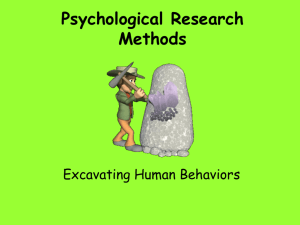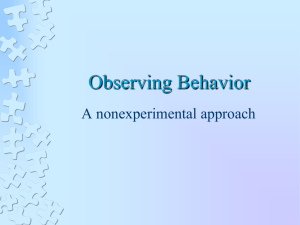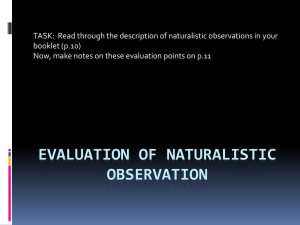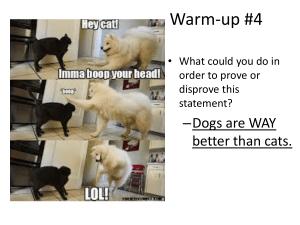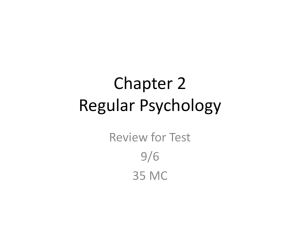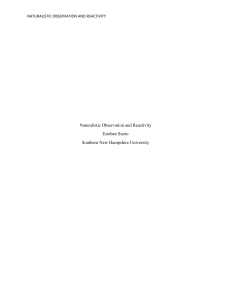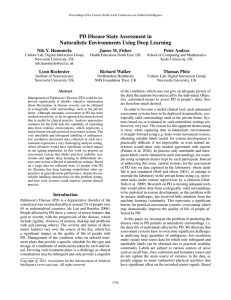PP for Chapter 2
advertisement
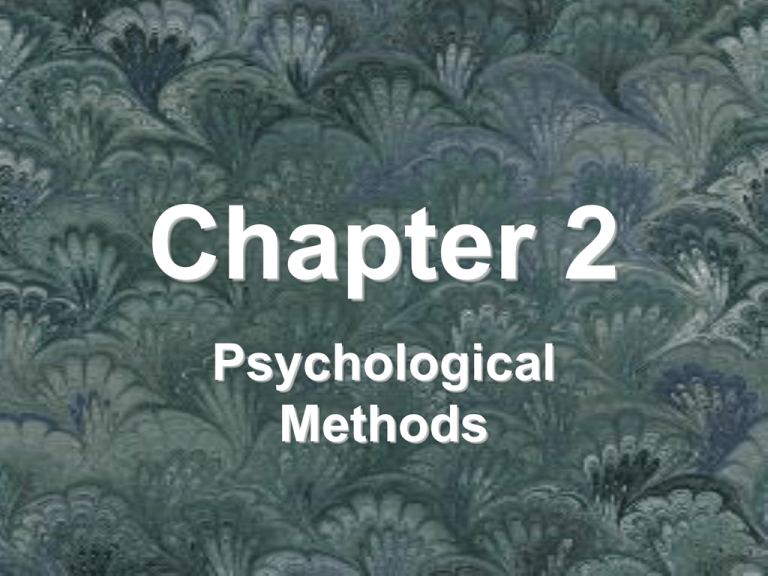
Chapter 2 Psychological Methods Conducting Research • • • • • • • Forming a research question Forming a hypothesis Testing the hypothesis Analyzing the results Drawing conclusions Replication New Questions • Examples: (a) Testing the effects of ritalin medication on the attention spans of children with ADHD (b) Examining the reliability of eyewitness testimony in young children The Psychological Method at work: • The “Mozart effect” is an increase in spatial reasoning scores after listening to a Mozart piano sonata. • Rats learned to complete a T-maze more quickly if they had been exposed in utero and reared hearing a Mozart piano sonata. Surveys, Samples, and Populations • • • • • Survey Method Populations and Samples Selecting Samples Generalizing Results Volunteer Bias Surveys: • People are asked to respond to a series of questions about a particular subject • Written questionnaires or interviewing orally • Problems with Surveys: – Honesty – Confidentiality – Please the interviewer – Ex. 1960’s survey of tooth brushing Surveys Populations and Samples: • What groups of people they wish to examine and how they are selected. –Target Population: the whole group you want to study or describe –Sample Population: part of the target population Target Population for “Text messaging Usage”? TEENAGERS Now a sample population from that Target Population? • Girls that text message • Hispanics that text message • Ages from 18-20 only, that text message Selecting Samples • Select samples that scientifically ensure they represent the population –Random- selected by chance –Stratified- subgroups in the population are represented proportionally Random Sample Stratified Sample Generalizing Results • Not using the words “all” because of the results • Researchers are careful about generalizing their finding to group other than those form which samples were drawn Volunteer Bias • Volunteers differ, sometimes, form those who do not volunteer. • Want to get those that do not want to take the survey, to take it. • Avoid surveying many enthusiastic volunteers Methods of Observation • The Testing Method • The Case-Study Method • Longitudinal and Cross sectional Methods • The Naturalistic-Observation Method • The Laboratory Observation • Methods of Analyzing Observations Testing Method • IQ Test- tests learning ability • Aptitude Test- specific abilities – Musical – Mechanical – Vocational • Personality Tests- character traits and temperament – Outgoing – Aggressive – Psychological Problems – Anxiety – Depression Testing Method Case Study Method • In depth investigation of an indivudal or a small group ( Ex. Genie); faulty in that people have problems with past experiences • Freud used this for his psychoanalytic theory Case Study Longitudinal Selected group of participants and then observe them over a period of time (years). Observe how they change over time. This is very time consuming, expensive, and risky Cross sectional • Selected sample that includes people of different ages to get the same result on a “cross section” of the population. • May not be as accurate • Much faster and cheaper NaturalisticObservation • Also known as a “Field Study” • Observe people or animals in their natural habitats. • Cannot interfere with the organism they are observing Naturalistic Observation • Dian Fossey studied Mountain Gorillas in Rwanda and Zaire. • She spent years watching and studying these Gorillas • She was murdered in 1985 Naturalistic Observation • Jane Goodall studied chimpanzees in Tanzania • She has studied them for 40 years Naturalistic Observation • Meerkat Manor is an example of naturalistic observation Naturalistic Observation Naturalistic Observation • Watching students eat lunch could be considered Naturalistic Observation • Maybe you can watch teachers eat… Laboratory Observation • Observe in a laboratory rather than in the field • Laboratory is any place that provides the opportunity for observation or experimentation Methods of Analyzing Observations • Correlations- a measure of how closely one thing is related to another. – Positive Correlation- one variable increases, the other also increases, or as one decreases so does the other. Both variables move in the same – Negative Correlation- one two variables tend to move in the opposite direction Positive Correlations • Achievement increased, salary increases • Temperature increases, anger increases Negative Correlation • The number of pages printed and the amount of ink left in your printer are negatively correlated. The more pages printed, the less ink you have left. Limits of Correlation • Does not reveal the cause and effect The Experimental Method • Independent and Dependent Variables • Experimental and Control Groups • Placebo Effect • Single Blind Studies • Double Blind Studies Independent Variable • The factor that researchers manipulate Dependent Variable • The factor that is being measured and that may change in response to the manipulating the Independent Variable Experiment • Warm temperature causes aggression in humans • Temperature is the independent variable (being manipulated) • Aggression is the dependent variable, because it reacts to the manipulation of the independent variable. Experimental Groups • The group that received the treatment Control Group • The group that does not receive the treatment Controlled Experiment • An experiment conducted with both a control group and an experimental group. Placebo Effect • The person’s belief in the treatment • Expectations. Hoping to feel better. • Ex. Sugar Tablets • Placebo-substance or treatment that has no effect apart from a person’s belief in it. Single Blind Studies • Participants do not know whether they received the treatment or not • Do not know if they are in the experimental group or the control group Double Blind Studies • Both participants and researchers are not aware of who received the placebo or the real treatment. • Otherwise, records are kept from both so that the outcome will not be skewed. • Information is taken by data analysis that is not involved with the experiment Ethical Issues • Research with people • Research with animals • Ethics in using data Research with People • Confidentiality- records are private • Informed consent- people agree to participate in research study only after they have been given a general overview of the experiment • Deception- only in specified conditions (pg 46) Research with animals • Psychologists only use animals when there is no alternative. • Some believe that the benefits outweigh the harm Ethics in Using Data • Objectivity in producing and presenting data • “Be willing to disregard hypothesis if it is incorrect after research” Statistics • Classify the types and uses of statistics in psychological research; include descriptive statistics and inferential statistics. Descriptive Statistics Descriptive statistics are used to describe the basic features of the data in a study. They provide simple summaries about the sample and the measures. In simple terms, descriptive statistics can be thought of as being just a straightforward presentation of facts Inferential statistics • You are trying to reach conclusions that extend beyond the immediate data alone . Quantitative Data Measures of Central Tendency • Mean- Average • Median- Middle • Mode- Most Frequently occurring . Example: Find the measures of central tendency for the data set 3, 7, 9, 4, 5, 4, 6, 7, and 9. A. Mean = 6, median = 6 and modes are 4, 7 and 9 B. Mean = 6, median = 6 and mode is 4 C. Mean = 6, median = 6 and modes are 4 and 9 D. Mean = 6, median = 9 and modes are 4, 7 and 9

